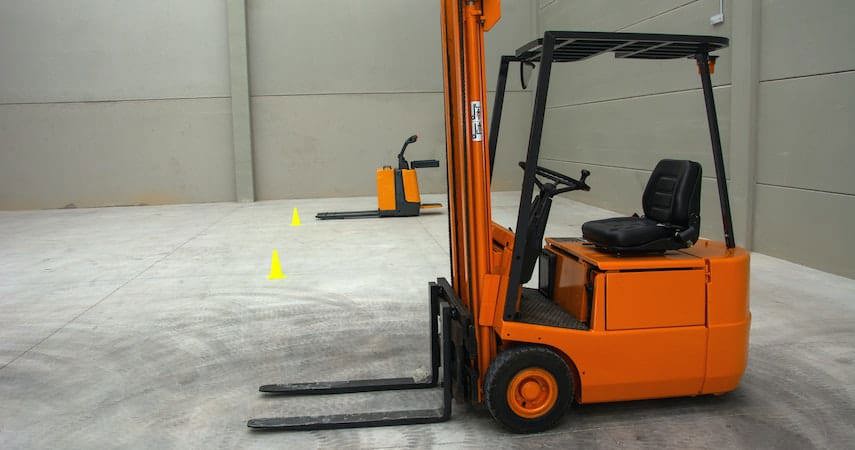
Managing a warehouse can be a complicated task. Multiple processes must be continually optimised to ensure maximum cost-savings, order accuracy, and efficiency. But when done correctly, everyone benefits: your customers, your stakeholders, and your staff.
Keep reading to discover how warehouse management works, gain a confident understanding of the typical warehouse team structure, and learn how to optimise your warehouse processes.
What is warehouse management?
Warehouse management involves overseeing the processes and activities within a warehouse to ensure efficient storage, handling, and distribution of goods or products. The goal of effective warehouse management is to maximise the use of available space, minimise handling costs, and streamline operations to meet customer demands effectively.
Warehouse management encompasses a range of tasks, including:
- Inventory tracking
- Order fulfilment
- Organising storage spaces
- Optimising layouts
- Managing personnel
Efficient and organised warehouse management plays a crucial role in supply chain management by contributing to timely deliveries and overall customer satisfaction. It can involve employing technology such as barcode scanners, inventory management software, and automated systems to enhance accuracy and speed in handling goods.
Warehouse management vs. inventory management
Warehouse management and inventory management are closely related aspects of logistics and supply chain management, but they focus on different elements of handling goods and products within a business.
Here’s the difference:
- Warehouse management: Warehouse management primarily deals with the physical storage, organisation, and movement of goods within a warehouse or distribution centre. It involves tasks like enhancing warehouse layouts, arranging inventory within the warehouse, managing personnel and equipment, and ensuring efficient order picking and packing.
- Inventory management: Inventory management focuses on maintaining optimal stock levels, forecasting demand, managing replenishments, and ensuring the availability of products to meet customer demand. It aims to strike a balance between having enough stock to fulfil customer orders while minimising excess inventory that ties up capital and storage space.
In short, warehouse management focuses on the organisation of warehouses or distribution centres and the processes used to run them, while inventory management deals with tracking goods within a facility and optimising on-hand inventory levels.

Warehouse management systems
A warehouse management system (WMS) is a software tool designed to streamline warehousing activities while reducing costs and minimising the risk of human error. It seeks to improve the efficiency with which a warehouse is operated.
Warehouse management software
Warehouse management software is a critical tool for streamlining warehouse operations. The specific requirements may vary depending on the size and complexity of the warehouse and the needs of the business.
Key features to look for in warehouse management software include:
- Storage optimisation
- Supplier and vendor management
- Integration with other systems
- User-friendly interface
- Mobile accessibility
- Security and access control
- Scalability
- Alerts and notifications
Consider the biggest challenges in your warehouse when shopping for warehouse management software. You probably don’t need all the bells and whistles, but it’s vital to find a system that solves the main problems you face on a daily basis.
Warehouse stock management software
Warehouse stock management software, also known as inventory management software, is a specialised tool designed to handle the tracking, organisation, and control of inventory within a warehouse. There are often features that crossover between warehouse management software and stock management software.
Key features to look for in warehouse stock management software include:
- Inventory tracking
- Order management
- Reporting and analytics
- Barcode integration
- Batch and serial number tracking
- Order processing and fulfilment
- Multi-location support
- Forecasting and demand planning
- Returns management
Warehouse stock management software plays an important role in refining the storage and handling of inventory within a warehouse. It provides tools to maintain accurate inventory records, streamline order processing, and improve overall warehouse efficiency.
Warehouse management processes
Warehouse management can be divided into several processes that contribute to the management of goods within the warehouse, caretaking of the warehouse, and the fulfilment of customer orders. Let’s look at a few of the main ones.
Receiving
Receiving is the initial step in the warehouse management process. It involves accepting and inspecting incoming shipments of products or materials from suppliers. Warehouse staff check the received items for accuracy, quantity, and quality, and they record this information in the inventory system.
Putaway
After receiving, the next step is putaway – or the putting away of received goods. This process involves assigning a specific storage location within the warehouse for each received item. Correct putaway ensures that products are stored in a manner that facilitates easy retrieval for order fulfilment.
Slotting
Slotting is the practice of strategically organising and rearranging products within the warehouse to improve efficiency. This involves considering factors like demand, product size, and picking frequency to determine the best storage locations for items.
Picking
Picking is the process of retrieving items from their storage locations within the warehouse to fulfil customer orders or replenish stock. It can be done manually by warehouse staff or automatically using technology like conveyor systems or robotic pickers.
Packing
Packing involves preparing the picked items for shipment. Warehouse staff assemble or gather the products, choose appropriate packaging materials, and label the packages with shipping information. Accurate and secure packing is essential to prevent damage during transit and minimise customer complaints.
Kitting
In manufacturing, kitting involves the assembly of components into finished goods. In order fulfilment, kitting is the process of creating product bundles or kits by combining multiple items into a single package. This is often done to simplify order fulfilment for products that are frequently purchased together.
Shipping
Shipping is the final step in the order fulfilment process. It involves loading the packed items onto delivery vehicles, generating shipping labels and documentation, and ensuring that the products are sent to the correct destinations promptly.
Inventory management
Warehouse inventory management encompasses all activities related to tracking, controlling, and optimising inventory levels within the warehouse. This includes tasks like cycle counting, managing reorder points, and minimising excess stock.
Reporting
Reporting involves the analysis and generation of reports that provide insights into warehouse performance. These reports can cover various aspects, such as inventory turnover, order accuracy, and overall productivity, helping managers make informed decisions.

Warehouse management tools and equipment
There are some useful tools and equipment that can assist in warehouse management. Amazon transformed their supply chain by digitising traditional warehouse processes to gain greater agility. What started as using barcode scanners to track inventory has evolved into a fully digital warehouse, distribution, and fulfilment network that moves goods between locations with incredible efficiency.
Here are some useful warehousing tools and equipment to consider:
- Forklifts: Forklifts are essential material-handling vehicles used in warehouses to lift, move, and stack heavy loads. They have forks at the front that can be raised or lowered to pick up palletized goods and transport them within the warehouse.
- Mobile scanners: Mobile scanners are handheld devices equipped with barcode or RFID technology. Warehouse staff use them to scan product labels which can help with tasks like inventory tracking, order picking, and verifying shipments.
- Docks: Docks are designated areas within a warehouse or distribution centre where trucks can load or unload goods. They typically have ramps or platforms that align with the truck bed, facilitating efficient movement of products in and out of the warehouse.
- Pallet trucks: Also known as pallet jacks, these manual or electric-powered tools are used to move pallets within a warehouse. They have forks that can be inserted under a pallet to lift and transport it short distances.
- Conveyors: Conveyors are mechanical systems designed to move items or materials from one point to another within a warehouse. They can be used for transporting products for sorting, packing, and loading goods onto trucks.
- Storage equipment: This category includes various types of shelving, racks, and storage systems used to organise and store inventory within the warehouse. Storage equipment helps with space utilisation and ensures easy access to products.
- Hand trucks: Hand trucks, also known as two-wheel dollies, are manual tools used for moving smaller loads. They consist of a vertical frame with two wheels and a flat platform or curved backrest to support and transport boxes or items.
- Mobile carts: Mobile carts are wheeled carts with multiple shelves or compartments used to transport and store smaller items within the warehouse. They are especially useful for order picking and kitting operations.
- Dollies: Dollies are flat platforms mounted on wheels, designed to transport heavy or bulky items that are difficult to carry by hand. They come in various sizes and configurations to accommodate different types of cargo.
- Packing tables: Packing tables are workstations equipped with tools and supplies for packing products. They typically include surfaces for preparing packages, as well as storage areas for packing materials like tape, boxes, and cushioning.
- Warehouse robotics: Warehouse robotics refers to automated machines and robots designed to perform tasks like picking, packing, and moving goods within a warehouse. These advanced systems can significantly increase productivity in warehouse operations.
Warehouse management tools and equipment play crucial roles in facilitating the various processes involved in storing, handling, and moving goods within a warehouse environment. Each tool serves a specific purpose and contributes to the overall performance of the warehouse.
Warehouse team: Structure and management
Depending on the size of a business and how it fulfils orders, a warehouse team can be large or only have a few personnel. In smaller organisations, a warehouse may be operated by a sole Operations Manager or Warehouse Manager.
Warehouse management roles
Here’s a quick look at some of the key roles involved in warehouse management:
- Warehouse manager: A warehouse manager oversees the overall operations of a warehouse facility. They are responsible for planning, organising, and coordinating activities such as receiving, storing, and shipping goods. Additionally, they often manage a team of warehouse staff, set performance targets, and ensure that safety standards are met.
- Warehouse supervisor: A warehouse supervisor is responsible for directly overseeing the work of warehouse staff. They assign tasks, monitor productivity, and ensure that operations run according to schedule. Additionally, they may be involved in training new employees and maintaining a safe working environment.
- Warehouse assistant: A warehouse assistant provides support to the warehouse team in various tasks. This can include tasks like preparing orders, receiving and inspecting shipments, organising inventory, and ensuring that the warehouse is kept clean and organised.
- Forklift operator: A forklift operator is trained to operate a forklift, which is a material-handling vehicle equipped with forks for lifting and moving heavy loads. They are responsible for safely manoeuvring the forklift to load and unload goods, as well as move them to different areas within the warehouse.
- Material handler: Material handlers are responsible for physically moving materials within the warehouse. They may use equipment like forklifts, pallet jacks, or hand trucks to transport goods to and from storage areas. They also assist in tasks like packing, labelling, and preparing products for shipment.
- Shippers and receivers: Shippers and receivers are responsible for handling incoming and outgoing shipments. Receivers verify the accuracy and condition of incoming goods, while shippers pack and prepare orders for outbound shipping. They play a crucial role in ensuring that the right products reach their intended destinations.

The role of a warehouse manager: 8 tips to manage warehouse employees
Effective warehouse management goes beyond just overseeing operations. It involves nurturing a positive work environment where employees feel supported and motivated to perform at their best.
By implementing the following tips, you can create a conducive and productive work atmosphere for your warehouse team:
- Clear communication: Foster open and transparent communication channels. Provide clear instructions, expectations, and updates regularly to ensure everyone understands their roles and responsibilities.
- Training and development: Invest in training programs to enhance employees' skills and knowledge. Continuous learning opportunities can empower them to perform tasks efficiently and adapt to changes in warehouse operations.
- Set clear goals and targets: Establish specific, measurable goals for individual employees and teams. This creates a sense of purpose and motivation and helps track progress and performance.
- Delegate responsibility: Empower employees by giving them ownership of certain tasks or areas. Trusting them with responsibilities promotes accountability and encourages them to take pride in their work.
- Safety first: According to a 2019 report by the U.S. Bureau of Labor Statistics, 4.4% of full-time transportation and warehouse workers were injured at work. Conduct regular safety training, enforce safety protocols, and ensure that employees have access to proper protective equipment. A safe working environment fosters employee confidence and well-being.
- Recognition and rewards: Acknowledge and celebrate employee achievements and milestones. Recognising their contributions, whether big or small, boosts morale and fosters a positive work culture.
- Regular feedback: Provide constructive feedback on performance. Regular check-ins and performance evaluations allow employees to understand their strengths, areas for improvement, and their progress towards meeting goals.
- Adaptability and flexibility: Recognize that warehouse operations may face unexpected challenges. Encourage adaptability and problem-solving skills among employees to effectively handle unforeseen situations.
How much does a warehouse manager make?
Warehouse managers are typically the highest-paid employees in the warehouse. Their role oversees the management and organisation of the various facilities and processes that enable efficient order fulfilment.
This table demonstrates how much warehouse managers make in different countries, based on research data from multiple sources:
|
Country |
Average Base Annual Salary |
|---|---|
|
United States |
|
|
United Kingdom |
|
|
Canada |
|
|
Australia |
|
|
New Zealand |
Warehouse manager interview questions
If you’re hiring a warehouse manager, it’s important to understand whether they’re the right fit for the job. Interviewing someone for the role of warehouse manager requires asking a particular set of questions designed to help you gain insight into their skills and capabilities.
Here are some warehouse manager interview questions you might ask:
- How do you prioritise tasks in a fast-paced warehouse environment?
- Can you share an example of a successful process improvement you implemented in a previous role?
- How do you ensure compliance with safety regulations and standards in the warehouse?
- How do you handle inventory management to prevent stockouts and overstock situations?
- How do you go about training and developing warehouse staff?
- Can you describe a situation where you had to resolve a conflict among warehouse staff members? How did you resolve it?
- How do you stay updated with industry trends and technologies in warehouse management?
- Can you share an example of a time when you had to adapt to unexpected changes in warehouse operations?
- What metrics or key performance indicators do you consider most important for evaluating warehouse performance?
- How do you ensure that the warehouse operates within budgetary constraints?
- Can you describe a time when you implemented a safety initiative that resulted in a significant reduction in accidents or incidents?
Don’t forget to throw in a few culture-related questions to ensure they are the right fit for your company and will get along easily with other staff.
Warehouse management strategies for improving efficiency
By implementing the right strategies, warehouse managers can significantly enhance the performance of their operations. Tailoring these approaches to the specific needs and circumstances of the warehouse can lead to even greater improvements in overall performance.
Here are 7 effective warehouse management strategies that improve efficiency:
- Optimise layout and organisation: Design the warehouse layout to minimise unnecessary movement and maximise storage capacity. Place high-demand items near packing stations and prioritise easy access to frequently picked products.
- Implement lean principles: Apply lean methodologies to eliminate waste, streamline processes, and enhance productivity. This includes practices like 5S (Sort, Set in Order, Shine, Standardise, Sustain) and Just-In-Time inventory management.
- Embrace technology and automation: Incorporate technologies like barcode scanners and automation solutions – such as conveyor systems and robotics – to increase accuracy and speed in handling goods.
- Prioritise inventory accuracy: Conduct regular cycle counts and invest in accurate tracking systems to ensure that inventory levels in the system align with physical stock. This reduces errors and prevents stockouts.
- Optimise picking strategies: Use efficient order-picking methods – such as batch picking, zone picking, or wave picking – to reduce travel time and increase the number of orders processed in a single run.
- Continuous training and development: Provide ongoing training to warehouse staff to improve their skills and knowledge. Well-trained employees are more efficient in their tasks and can adapt to new technologies and processes.
- Monitor Key Performance Indicators (KPIs): Regularly track and analyse KPIs such as order accuracy, on-time delivery, inventory turnover, and picking efficiency. This data provides insights into performance and helps identify areas for improvement.

Lean warehouse management
Lean warehouse management is a systematic approach aimed at minimising waste and maximising productivity in warehouse operations. It draws its principles from the broader Lean methodology, which originated in manufacturing and emphasises continuous improvement and value creation.
In the context of warehouses, lean management involves several key aspects:
- Waste reduction: Lean warehouse management focuses on identifying and eliminating various forms of waste, including excess inventory, unnecessary motion, overproduction, and waiting times. By reducing these inefficiencies, resources are better utilised.
- Just-In-Time (JIT) inventory: Lean promotes the principle of Just-In-Time, which means receiving and moving goods in the warehouse precisely when they are needed. This minimises excess inventory and carrying costs, as products are ordered and stored based on actual demand.
- 5S Methodology: This system involves five steps – Sort, Set in Order, Shine, Standardise, Sustain – to organise and maintain a clean and efficient workspace. It helps create an organised and visually clear environment, reducing the chances of errors and improving safety.
- Pull System: In contrast to a push system, where products are pushed through the supply chain regardless of demand, lean warehouse management employs a pull system. This means that products are only moved or produced in response to specific customer orders, reducing the risk of overproduction.
- Continuous Improvement (Kaizen): Lean encourages a culture of continuous improvement, where employees are empowered to identify and address inefficiencies in their processes. This involves regularly reviewing and refining workflows for better performance.
- Standardised work: Lean emphasises establishing standardised work procedures that are clear, efficient, and consistently followed by all employees. This reduces variations in how tasks are performed, leading to improved consistency and quality.
- Visual management: Visual cues and signals are used to provide information about the status of operations. This can include visual indicators for inventory levels, workflow progression, and order status, making it easier for employees to understand and respond to changing conditions.
- Multi-skilled workforce: Cross-training employees to perform multiple tasks enables flexibility in resource allocation. This ensures that workers can adapt to changing demands within the warehouse, improving overall supply chain agility.
- Customer focus: Lean emphasises understanding and meeting customer needs and expectations. This involves aligning warehouse operations with customer demand patterns, ensuring timely and accurate order fulfilment.
- Employee engagement and empowerment: Lean principles encourage involving employees in problem-solving and decision-making processes. This empowers them to take ownership of their work and contribute to the continuous improvement efforts.
